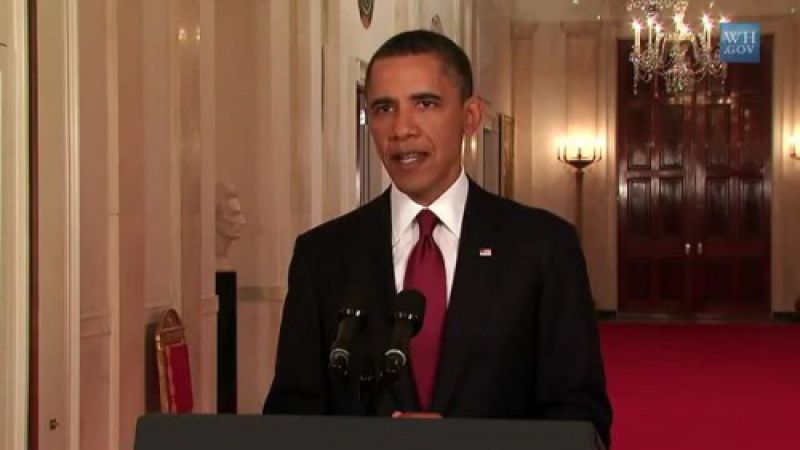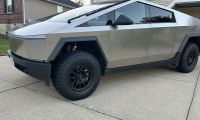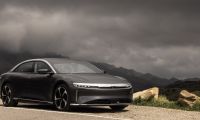Johnson Controls Chairman and CEO Stephen A. Roell said today his company has tried hard to innovate and create jobs.
"Through innovation and investment in technology and people, Johnson Controls is a leader in the energy storage industry. We are investing more than $460 million in our advanced battery business for manufacturing and technical facilities here in Michigan and the U.S. These investments will lead to over 700 new jobs, retention of another 400 and approximately 1,000 construction jobs," Roell said.
"We want to express our appreciation to President Obama for his leadership on improving the energy efficiency of buildings and his support of the auto industry. We are honored that he has selected to tour our facility."
The president gave a 25-minute speech to about 200 people at the Holland plant and shook almost everyone's hand at the lecturn. During President Obama's tour, he remarked that it was “very cool,” to see Johnson Controls employee John Park use an “automatic storage and retrieval frame” used to make advanced batteries, according to a White House press pool release.
Today’s trip builds on President Obama's announcement of 54.5 mpg standards for cars and family trucks by 2025 and which, combined with steps already taken by the Obama administration, will save American families $1.7 trillion at the pump. It also builds on the new fuel-efficiency standards for work trucks, buses and other heavy-duty vehicles, which will save American businesses who operate and own these commercial vehicles $50 billion in fuel costs.
Proposed 2017-25 standard will provide certainty to investors in job-creating advanced vehicle technologies. Providing a single national cars program through 2025 provides the certainty required for companies to invest in new technologies in the U.S. that will make it possible to build more efficient cars and trucks. This, in turn, will stimulate the creation of good-paying jobs across the U.S to design and build advanced vehicles and all their component parts.
The auto industry employs 700,000 people in manufacturing vehicles and vehicle parts and many thousands more providing materials like steel, rubber, plastic, and aluminum that go into the vehicles we drive. This represents the single largest manufacturing industry in the United States. Since July of 2009, the automotive sector has added approximately 113,000 jobs, its strongest period of job growth since the late 1990s, much of this growth coming from manufacturers of vehicle parts.
Proposed 2017-25 standards will include incentives for game-changing technologies. Achieving the aggressive fuel economy goals set through 2025 will encourage automakers’ use of advanced technologies. As the Environmental Protection Agency and the Department of Transportation develop the new standards, they are considering a number of specific incentive programs to encourage early adoption and introduction into the marketplace of advanced technologies that represent “game changing” performance improvements, helping to improve fuel economy through 2025 and beyond. These incentives include:
1. Incentives for electric drive vehicles: By providing incentives for electric vehicles, fuel cell vehicles, and plug-in hybrid electric vehicles, the new standards will build on the Administration’s efforts to foster innovation, bring down costs, expand the U.S. share of the advanced battery market, and put a million electric vehicles on the road by 2015.
2. Incentives for advanced technology packages for large pickups: These include hybridization and other performance-based strategies.
3. Off-Cycle Innovative Technology Credits: These credits reward the use of innovative technologies that reduce vehicle carbon emissions and/or fuel consumption, but whose reduction benefits are not captured over the two-cycle test procedure used to determine compliance with the fleet average standards (i.e., “off-cycle”). EPA and DOT intend to expand and streamline the existing off-cycle credit provisions, which would benefit a variety of off-cycle innovations like “Start-Stop” technology, in which the engine shuts off as the driver stops in traffic or at a red light – rather than consuming fuel while idling. Start-stop systems rely on energy from the battery, not the engine, to provide electrical power to the car.
Manufacturing cutting edge batteries and creating jobs at Johnson Controls Inc.
In August 2009, President Obama announced $2.4 billion in Recovery Act grants for advanced vehicle battery technology. Johnson Controls was selected to receive $300 million to build domestic manufacturing capacity for advanced batteries for hybrid and electric vehicles. So far, this investment has created or saved about 150 jobs. It is also leveraging additional investment, representing only about half of Johnson Controls's total planned investment of $600 million in domestic advanced battery manufacturing capacity.
Today, this grant has enabled Johnson Controls Inc. to open its first domestic lithium-ion plant in Holland. The company is also taking additional steps to develop and deploy advanced technology – including implementing a recently announced plan to retrofit an existing battery plant outside of Toledo to focus on manufacturing batteries used to support Start-Stop technology. The company estimates the conversion will create 50 jobs.
Investments in facilities like the Johnson Controls plant in Holland are already transforming the advanced vehicle batteries industry in the United States. In 2009, the U.S. had only two factories manufacturing advanced vehicle batteries and produced less than two percent of the world’s advanced batteries. But over the next few years, the United States will be able to produce enough batteries and components to support 1 million plug-in hybrid and electric vehicles, thanks to strategic Recovery Act investments and the Advanced Technology Vehicle Manufacturing loan program.
Building manufacturing capacity will reduce cost through economies of scale, and so will research and development. Federally-funded research and development has made tremendous progress already, reducing the cost of lithium-ion batteries from $1,300 per kilowatt-hour in 2007 to $650 / kWh today, dramatically faster than expected only two years ago, and well on track to meet our goal of $300 / kWh.
Helping accelerate advanced vehicle technologies. In conjunction with President Obama’s visit to Holland, the Department of Energy on Wednesday announced support for 40 projects in 15 states totaling more than $175 million to quicken the development and deployment of innovative and advanced vehicle technologies, which will help create jobs and ensure that the U.S. stays competitive in the automotive industry for decades to come.
The selections focus on a variety of innovative approaches to improve advanced vehicle efficiency, including: advanced fuels and lubricants, light-weight materials, advanced cells and design technology for electric drive batteries, advanced motor technology, improved engine efficiency technology, fleet efficiency, and advanced testing and evaluation.
Projects undertaken by Johnson Controls include:
Start-Stop Vehicle Technology, near Toledo
Johnson Controls is investing $138.5 million to convert and expand an existing plant to produce batteries for Start-Stop vehicles that have been successful in the European market and will be introduced next year in the U.S. These batteries help reduce fuel consumption and emissions by 5-12% for internal combustion engine vehicles with little added cost for the consumer. This investment will retain 400 jobs and create 50 new positions and 800 construction jobs.
Battery Technology and Test Center, Milwaukee
Johnson Controls opened a newly renovated Battery Technology and Testing Center in Milwaukee. It is the largest energy storage R&D center in the country with 60 new jobs.
Meadowbrook Li-ion Battery Production Facility, Holland
This new facility will be the first in America to produce complete lithium-ion battery cells and systems for hybrid and electric vehicles, producing battery systems for U.S. based automakers, such as Ford's Transit Connect. The facility was supported in part by a $299.2 million American Recovery and Reinvestment Act matching grant and more than $168 million in incentives from the state of Michigan. Johnson Controls invested $299.2 million to match the ARRA grant and more. Employment at this facility will be 320 at full capacity. Johnson Controls has committed to building a second facility in U.S. Once a location is identified and the facility constructed, it would add nearly 300 additional jobs when at full capacity.
Here is a background statement describing the Holland facility from a Johnson Controls Web site:
The 750,000-square-foot technical campus in Holland opened in 1987 as the Prince Corp. headquarters. After the purchase of Prince Corp. in 1996 by Johnson Controls, the facility continued as the Edgar D. Prince Technical Campus housing Design, Engineering, Product Development, Customer Business units, Advanced Manufacturing and Validation for interior systems and components as well as the growing electronics business. The building is approximately a quarter-mile long and currently houses over 1,000 employees. Holland is a 15-minute plane ride east across Lake Michigan from the Milwaukee corporate offices and is located two hours north of Chicago and three hours west of Detroit.
You can reach TN's Hawke Fracassa at [email protected].
Image source: Wikipedia
Related reading
http://www.torquenews.com/1063/president-obama-you-cannot-bet-against-american-worker











